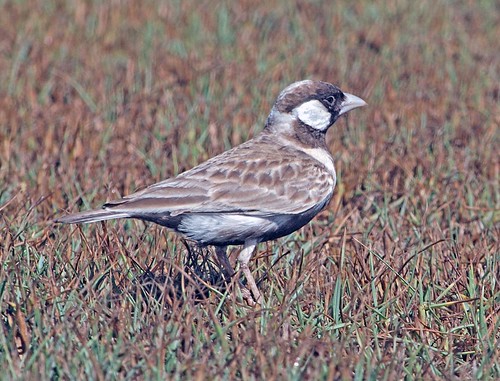tags: Grey-Backed Sparrow-Lark, Eremopterix verticalis, birds, mystery bird, bird ID quiz
[Mystery bird] Grey-Backed Sparrow-Lark, Eremopterix verticalis, photographed in Swakopmund, Namibia, Africa [I will identify this bird for you in 48 hours]
Please name at least one field mark that supports your identification.
The photographer, Dr. Dennis Paulson, Director Emeritus of the Slater Museum of Natural History, writes;
Sparrow-larks are bona fide larks, but their bills are modified for seed-eating, so they are very sparrow-like. They are also small and short-tailed for larks, and with their sparrow bills and their patterns vaguely reminiscent of the House Sparrow genus (Passer), their common name is quite appropriate. This species, as its name implies, is distinguished from similar sympatric species by its plain gray-brown back. Sparrow-larks are sexually dimorphic, unlike most larks, and females are plain light buffy brown with fine streaks, looking much more like a typical lark except for their bill. One characteristic of larks is their very long tertials, the basal flight feathers that overlap the primaries when the wing is folded and probably serve to protect the outer primaries from UV damage. This is a valuable adaptation for open-country birds.
- Log in to post comments


I guess pranticole or courser (species unknown), based on head shape, body shape, beak shape, and leg length.
Please go easy on me; I am twelve, and this is my first time guessing!
My first impression was some sort of weaver. The more I look at it the more is looks like a ... house sparrow? But why would someone in Manhattan go all the way to Namibia for something that is surely sitting outside her window? I therefore hope that I am wrong and it is some ultra-exotic African weaver.
Grey-backed Sparrowlark/Finchlark (Eremopterix verticalis)?
It has the white cheek and dark throat and crown that some Eremopterix have. In addition it has a paler back than Chestnut-backed Sparrowlark (E. leucotis), and has some white feathering on the crown that leucotis lacks.
Pratincoles and coursers have much thinner bills.
@ ground petrel:
We have a saying at our hawkwatch -- it's only a mistake once it's put into the data. Until then, it's just a working hypothesis, and those are often wrong. The idea is to make sure people feel willing to try, even if they don't get the right call at first. So ... keep guessing. And read the following responses and learn from them. Maybe when you're 80, you'll get them all right. I'm halfway there, and I certainly don't know what this bird is.